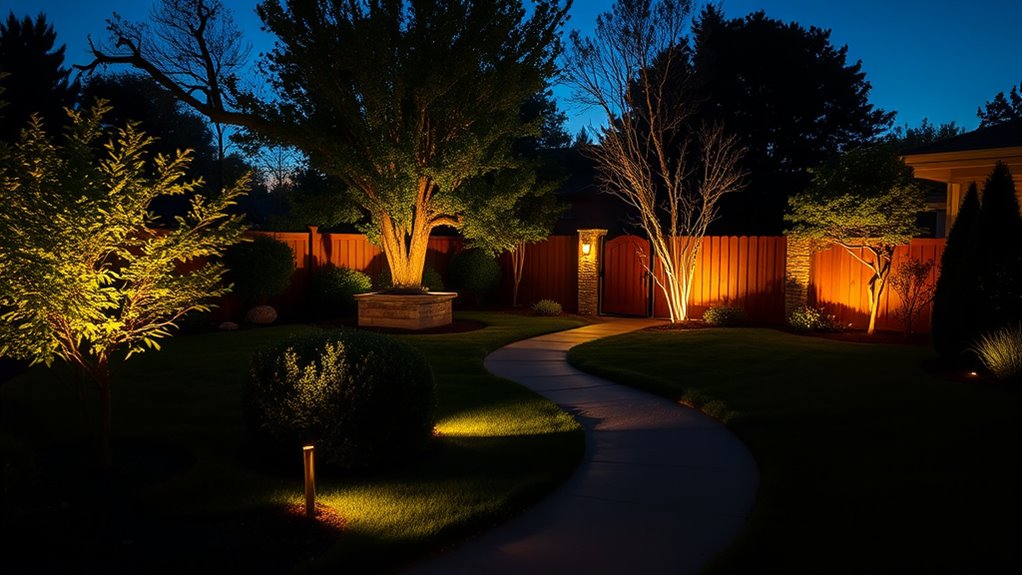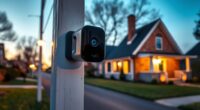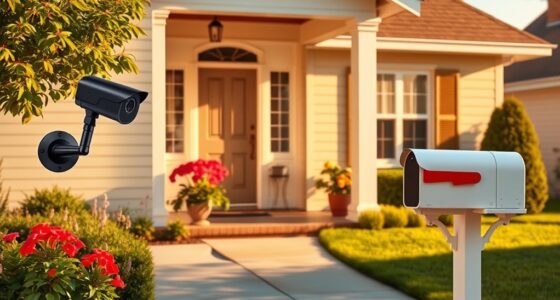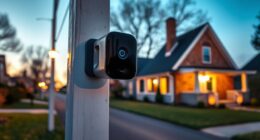To deter crime in your yard, install strategic lighting around entry points, dark corners, and pathways. Use motion sensors that activate lights instantly, startling intruders and drawing attention. Illuminate walkways to guide visitors safely and prevent hiding spots. Combining pathway and security lights with timers or smart controls enhances coverage and efficiency. Consistent, well-placed lighting creates an environment that discourages malicious activity. Keep exploring for more tips on making your yard a safer place.
Key Takeaways
- Strategically place motion-activated lights near entry points and dark corners to detect and deter intruders effectively.
- Combine pathway lighting with low-voltage fixtures to guide visitors and eliminate hiding spots around your yard.
- Use timers or smart lighting systems to ensure consistent illumination during nighttime hours for enhanced security.
- Install lights at key points to create a hostile environment for potential criminals and increase overall property visibility.
- Regularly maintain and update your outdoor lighting to ensure optimal coverage and effectiveness in crime prevention.
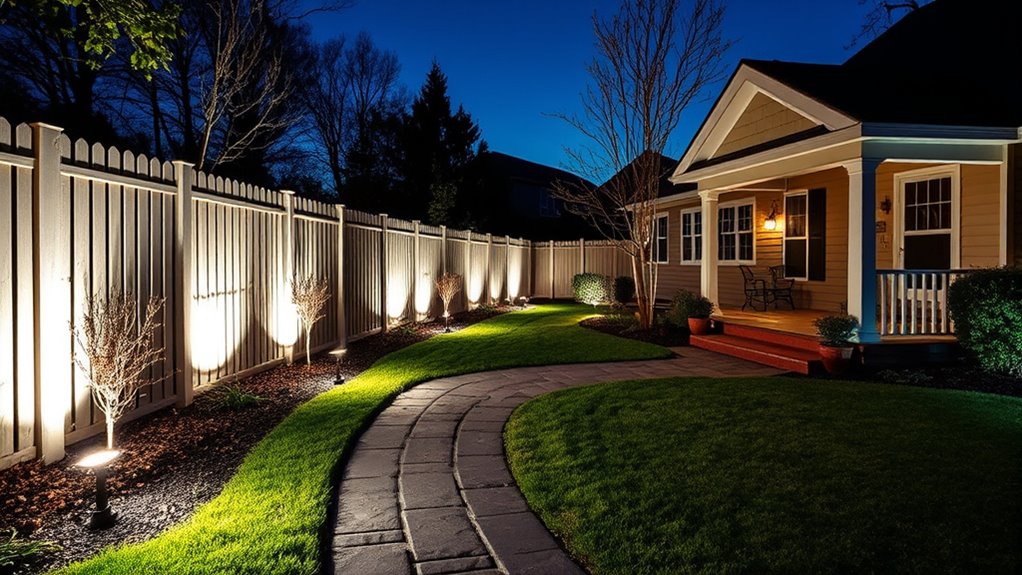
Effective lighting is one of the most straightforward ways to reduce crime in your community. When your yard is well-lit, potential intruders are less likely to target your property because they prefer to operate where they’re less exposed. Installing strategic lighting isn’t just about keeping your home visible; it’s about creating a hostile environment for anyone with malicious intent. Two of the most effective tools for this purpose are motion sensors and pathway illumination. These elements work together to enhance your yard’s security without wasting energy or creating unnecessary light pollution.
Motion sensors are a game-changer when it comes to deterring crime. You set them up around key areas—entry points, dark corners, or secluded spots—and they activate lights instantly when they detect movement. This sudden burst of light startles intruders and draws attention to their presence, which can be enough to make them reconsider their plans. Plus, motion sensors add convenience because the lights only turn on when needed, saving you money on energy bills. When you’re approaching your driveway or backyard, these sensors ensure you don’t stumble around in the dark, providing safety for your family and visitors. They also give you peace of mind knowing that any unexpected activity nearby will trigger a bright light, alerting you to potential threats.
Pathway illumination is another vital aspect of crime-deterring lighting strategies. Clear, well-lit pathways lead visitors safely to your front door and prevent accidental trips or falls. But beyond safety, pathway lighting also signals that your property is actively maintained and monitored, which can discourage would-be burglars from approaching. You can achieve this by installing low-voltage lights along walkways, garden edges, or fences. This type of illumination creates a visible boundary around your yard, making it harder for intruders to hide in shadows. Additionally, pathway lights can be set on timers or connected to smart home systems, ensuring they stay on during the night without your constant intervention. This consistent lighting makes it more difficult for someone to approach your home unnoticed, especially if combined with motion sensor activation at key points.
Frequently Asked Questions
What Are the Cost Implications of Different Outdoor Lighting Options?
You’ll find that cost comparison varies widely among outdoor lighting options. Solar lights are budget-friendly with low installation expenses, requiring only sunlight exposure. LED lights cost more initially but save money on energy bills long-term. Traditional wired fixtures involve higher installation expenses but offer durability. Consider your yard size and security needs to balance upfront costs with long-term savings, ensuring you choose a lighting option that fits your budget and deters crime effectively.
How Does Lighting Affect Local Wildlife and Plant Life?
Lighting can be a double-edged sword that affects your yard’s ecosystem. It causes wildlife disruption by confusing nocturnal animals and impacts plant growth by altering natural light cycles. Think of it as a silent predator that changes behaviors and growth patterns. To minimize these effects, use motion-activated or downward-shielded lights, and avoid bright, blue-toned LEDs. Your thoughtful choices help protect local wildlife and support healthy plant development.
Can Solar-Powered Lights Be as Effective as Wired Lighting?
Yes, solar-powered lights can be just as effective as wired lighting if you select high-quality options. Focus on solar efficiency to guarantee they absorb enough sunlight during the day, and consider battery lifespan to maintain consistent illumination overnight. Proper placement and regular maintenance help maximize their performance. While they might not always match wired lighting in brightness, modern solar lights are a reliable, eco-friendly alternative for crime deterrence and yard visibility.
What Maintenance Is Required for Outdoor Lighting Systems?
You need to stay vigilant with outdoor lighting maintenance. Regularly check bulb longevity to make sure your lights stay bright, replacing bulbs before they burn out. Keep cleaning routines consistent—dirt and debris can dim lights and obscure security. Watch for rust or damage, and tighten connections as needed. Staying proactive guarantees your lighting system remains effective, warding off trouble and keeping your yard safe and well-lit night after night.
Are There Any Legal Restrictions on Outdoor Lighting Brightness?
Yes, there are legal restrictions on outdoor brightness in many areas. You should check local regulations because they often limit outdoor brightness to prevent light pollution and protect neighbors’ night vision. These restrictions may specify maximum lumens or restrict certain types of lighting. By staying within these legal limits, you can guarantee your outdoor lighting remains compliant and effective, deterring crime without causing unnecessary light intrusion.
Conclusion
Think of your yard as a fortress, and proper lighting as your shining shield. By implementing these crime-deterring strategies, you create a landscape that wards off intruders like a lighthouse guiding ships away from danger. Don’t let darkness be your weakness; illuminate every corner and corner post. With the right lighting, your yard becomes a beacon of safety, making it clear that you’re watching and protecting what’s yours. Brighten your space and keep trouble at bay.
